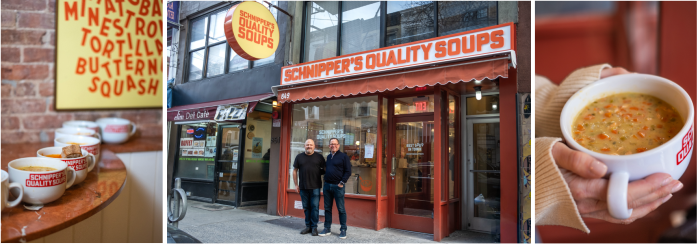-
 As the main culinary expert in the duo, Madhuri, left, is responsible for coming up with all of Saffron Fix’s recipes. The key, she says, is being able to filter through thousands of versions of the same Indian dish to find the simplest one. “If it’s too many ingredients, let’s modify it and make it easier,” she says. “What can we eliminate and still maintain the flavor?”
As the main culinary expert in the duo, Madhuri, left, is responsible for coming up with all of Saffron Fix’s recipes. The key, she says, is being able to filter through thousands of versions of the same Indian dish to find the simplest one. “If it’s too many ingredients, let’s modify it and make it easier,” she says. “What can we eliminate and still maintain the flavor?”
Not only does that speed up the cooking process, it also makes the meal more authentic, according to Ankita. Too often, Indian restaurants will load up their dishes with heavy cream, extra spices and oil. Health-conscious diners end up getting the wrong impression that South Asian cuisine is not suitable for their diet.
At home, however, the consumer is in control. Ankita believes that changes the perception of the cuisine. “You control the amount of oil that you put in,” she tells me. You control the amount of spices.”
” data-id=”113273944″ data-link=”https://amnewyork.wpengine.com/wp-content/uploads/2019/10/12989_image.jpg” class=”wp-image-1.13273944″/>
Photo Credit: Cole Riley -
 Before receiving orders, the team must spend a few days packing all the ingredients in bulk to prepare for future shipments. Spices and naan, both dry ingredients, are often packaged first at a small rented kitchen space in Long Island City.
Before receiving orders, the team must spend a few days packing all the ingredients in bulk to prepare for future shipments. Spices and naan, both dry ingredients, are often packaged first at a small rented kitchen space in Long Island City.
“It’s all local produce,” Ankita explains. Behind her, two employees are diligently spooning measured amounts of chili powder, cumin and bay leaves into small plastic cups. “We try to get as high-quality ingredients as we can.”
” data-id=”113273946″ data-link=”https://amnewyork.wpengine.com/wp-content/uploads/2019/10/12992_image.jpg” class=”wp-image-1.13273946″/>
Photo Credit: Cole Riley -
 The small cups of spices also allow adventurous foodies to try something new without being fully committed to buying an entire box of expensive seasoning. And, who knows — curiosity might breed a new trend.
The small cups of spices also allow adventurous foodies to try something new without being fully committed to buying an entire box of expensive seasoning. And, who knows — curiosity might breed a new trend.
“Everyone is crazy over gochujang (Korean chili paste) right now,” Madhuri says. “Same thing could happen to Indian food. Suddenly Kashmiri chili powder could be selling.”
” data-id=”113273956″ data-link=”https://amnewyork.wpengine.com/wp-content/uploads/2019/10/13450_image.jpg” class=”wp-image-1.13273956″/>
Photo Credit: Cole Riley -
 Next up, meat and produce. These ingredients are packed in a larger kitchen space in the same Long Island City production center where there’s more room to peel, shred and cut all the vegetables, and store the meat in an ice locker until it’s ready to be taken out.
Next up, meat and produce. These ingredients are packed in a larger kitchen space in the same Long Island City production center where there’s more room to peel, shred and cut all the vegetables, and store the meat in an ice locker until it’s ready to be taken out.
” data-id=”113273968″ data-link=”https://amnewyork.wpengine.com/wp-content/uploads/2019/10/12996_image.jpg” class=”wp-image-1.13273968″/>
Photo Credit: Cole Riley -
 The day I visited, the two women had three employees helping them prepare the meat and vegetables. Other times Ankita and Madhuri will recruit a rotating staff of graduates from Emma’s Torch, a New York City-based job training program that helps international refugees find careers in the culinary industry.
The day I visited, the two women had three employees helping them prepare the meat and vegetables. Other times Ankita and Madhuri will recruit a rotating staff of graduates from Emma’s Torch, a New York City-based job training program that helps international refugees find careers in the culinary industry.
“We wanted to do some social good by hiring and using people who can use that work, who usually find it difficult to make minimum wage,” Ankita says.
” data-id=”113273943″ data-link=”https://amnewyork.wpengine.com/wp-content/uploads/2019/10/20084_image.jpg” class=”wp-image-1.13273943″/>
Photo Credit: Cole Riley -
 Across from Ankita, a female employee is carefully labeling the containers of diced tomatoes, an integral ingredient to many modern Indian dishes.
Across from Ankita, a female employee is carefully labeling the containers of diced tomatoes, an integral ingredient to many modern Indian dishes.
” data-id=”113273961″ data-link=”https://amnewyork.wpengine.com/wp-content/uploads/2019/10/12998_image.jpg” class=”wp-image-1.13273961″/>
Photo Credit: Cole Riley -
 From the production kitchen to your doorstep — now it’s time to cook.
From the production kitchen to your doorstep — now it’s time to cook.
To keep the ingredients fresh and cool, each Saffron Fix meal kit comes with a temperature-control liner and several gel ice packs.
“The idea is that it should cool while it’s in transit,” Ankita explains. “When you get it, [the gel ice packs] should still be semi-frozen.”
” data-id=”113274104″ data-link=”https://amnewyork.wpengine.com/wp-content/uploads/2019/10/13001_image.jpg” class=”wp-image-1.13274104″/>
Photo Credit: Cole Riley -
 We are in Ankita’s apartment making Mughlai Shahi Paneer or “Royal Paneer.” It’s an ancient dish that was once served in the courts during the reign of the Mughal Empire. Paneer is a traditional Indian cottage cheese made from curdling heated milk with lemon juice.
We are in Ankita’s apartment making Mughlai Shahi Paneer or “Royal Paneer.” It’s an ancient dish that was once served in the courts during the reign of the Mughal Empire. Paneer is a traditional Indian cottage cheese made from curdling heated milk with lemon juice.
Some recipes include tomatoes making the sauce red, the recipe card reads. But traditional Mughlai cuisine lacks tomatoes, since they were foreign to India at the time.
“We like to educate people on the different versions [of the dish],” Madhuri explains.
” data-id=”113274103″ data-link=”https://amnewyork.wpengine.com/wp-content/uploads/2019/10/13005_image.jpg” class=”wp-image-1.13274103″/>
Photo Credit: Cole Riley -
 To begin, Madhuri adds a few drops of ghee (South Asian clarified butter) to a heated pan. She then sprinkles in the shahi jeera (caraway seeds) and ginger-garlic paste, which is ground from scratch.
To begin, Madhuri adds a few drops of ghee (South Asian clarified butter) to a heated pan. She then sprinkles in the shahi jeera (caraway seeds) and ginger-garlic paste, which is ground from scratch.
“We assume that people don’t want to blend and pressure cook,” she says. “So whenever it’s ground [ingredients], we try to grind it ourselves as much as possible.”
” data-id=”113274106″ data-link=”https://amnewyork.wpengine.com/wp-content/uploads/2019/10/13007_image.jpg” class=”wp-image-1.13274106″/>
Photo Credit: Cole Riley -
 Once the mixture begins to sizzle, Madhuri adds the fried onions, cashew paste, a blend of various spices, and half a cup of yogurt. The entire bag of raw paneer goes in last. The aroma becomes intoxicating; the buttery smell of ghee and yogurt begins to fill the air. Thirty minutes later, the cooking is done — no prep time wasted.
Once the mixture begins to sizzle, Madhuri adds the fried onions, cashew paste, a blend of various spices, and half a cup of yogurt. The entire bag of raw paneer goes in last. The aroma becomes intoxicating; the buttery smell of ghee and yogurt begins to fill the air. Thirty minutes later, the cooking is done — no prep time wasted.
“It’s pretty amazing,” Ankita quips from her perch on the counter, watching Madhuri spoon the creamy contents of the pan into a bowl. “You can come home from work very tired but, because there’s no prep, you can get it done quickly.”
” data-id=”113274100″ data-link=”https://amnewyork.wpengine.com/wp-content/uploads/2019/10/13463_image.jpg” class=”wp-image-1.13274100″/>
Photo Credit: Cole Riley -
 Finally, the Mughlai Shahi Paneer is ready to eat. I rip off a piece of toasted naan, scoop up a heaping portion and take a bite. It’s surprisingly light, unburdened by oil or butter yet full of flavor from the yogurt and spices. I take a second bite, then a third. The meal is absolutely delicious.
Finally, the Mughlai Shahi Paneer is ready to eat. I rip off a piece of toasted naan, scoop up a heaping portion and take a bite. It’s surprisingly light, unburdened by oil or butter yet full of flavor from the yogurt and spices. I take a second bite, then a third. The meal is absolutely delicious.
Madhuri says the secret to a dish like this lies in “blooming” the spices, a technique that refers to toasting spices in ghee or oil first to deepen their flavor.
“A lot of other countries have actually taken Indian cooking techniques into their cuisines,” she says.
” data-id=”113274108″ data-link=”https://amnewyork.wpengine.com/wp-content/uploads/2019/10/13466_image.jpg” class=”wp-image-1.13274108″/>
Photo Credit: Cole Riley -
 So much to learn from just one 30-minute meal. But that’s exactly what Ankita and Madhuri are hoping to achieve through Saffron Fix. “We want [Indian food] to be as familiar as Italian food is in America,” Madhuri says.
So much to learn from just one 30-minute meal. But that’s exactly what Ankita and Madhuri are hoping to achieve through Saffron Fix. “We want [Indian food] to be as familiar as Italian food is in America,” Madhuri says.
It’s a bold goal; Italians were among the first groups of immigrants to arrive in the United States in the 1900s and have spent decades spreading their cuisines. Still, these two entrepreneurs are hopeful.
“If we can prove to people that Indian food is popular enough to bring into your kitchen, everything else will trickle down from there,” Madhuri explains. “You’ll see more products in your supermarket, you’ll see more chefs investing in high-end Indian cuisine. It’ll become more familiar.”
” data-id=”113274102″ data-link=”https://amnewyork.wpengine.com/wp-content/uploads/2019/10/13467_image.jpg” class=”wp-image-1.13274102″/>
Photo Credit: Cole Riley -
 Eventually, the women hope to transform their company into a one-stop-shop for all things Indian — meals, recipes and wholesale ingredients. For now, they’re just focused on expanding the Saffron Fix menu to include more fusion options, mixing traditional Indian flavors with tacos, quinoa bowls and salads.
Eventually, the women hope to transform their company into a one-stop-shop for all things Indian — meals, recipes and wholesale ingredients. For now, they’re just focused on expanding the Saffron Fix menu to include more fusion options, mixing traditional Indian flavors with tacos, quinoa bowls and salads.
Case in point, April’s menu will feature a Veggie Masala Burger.
“Let us introduce you to your new favorite burger!” the recipe card reads. At only 200 calories, it might just be.
” data-id=”113274105″ data-link=”https://amnewyork.wpengine.com/wp-content/uploads/2019/10/13470_image.jpg” class=”wp-image-1.13274105″/>
Photo Credit: Cole Riley
As she stirs the bright yellow curry simmering on the stove in front of her, Madhuri Sharma, 32, lets me in on a little culinary secret.
“Cashew paste is actually a great way to make something creamy without adding any cream,” Madhuri says, her voice confident from years of culinary school. She grabs a small plastic cup of pre-measured paste from the counter, dumps it into the curry, and continues to stir.
The nut purée starts to dissolve. Suddenly, the dish she is cooking turns from a chunky concoction into a velvety stew. Within 30 minutes, it’s ready to be served. Wow, I think to myself. Indian food is pretty neat.
That’s the idea behind Saffron Fix, a new, New York City-based food delivery startup co-founded by Madhuri Sharma. The goal is to make Indian cuisine more approachable by sending customers the ingredients to make their own dishes from scratch. Madhuri and her co-founder, Ankita Sharma (no relation), came up with the concept in 2014 when they found many of their friends craving meals from the South Asian subcontinent but were unable to find the ingredients to cook it themselves.
“I didn’t even make [Indian food] for myself because I didn’t know where to find paneer,” Ankita, a native of northern India, recalls. “I didn’t know where to find garam masala.”
With Saffron Fix, the elusive search for exotic spices is taken out of the customer’s hands. Each temperature-controlled box comes with two or three recipes, and enough pre-chopped ingredients to serve two people per recipe. One box delivered every two weeks is $50; customers just looking to get a taste of the service can also opt to order one box of two or three recipes without any commitment starting at $50.
The startup officially launched late last year and now serves customers in over 20 states across the country. I caught up with Ankita and Madhuri during one of their prep weeks to learn more about the company and how the whole process works.




































